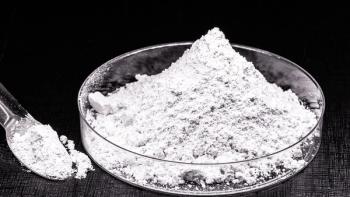
- Pharmaceutical Technology-02-01-2017
- Volume 2017 Supplement
- Issue 1
Collaborating for Efficiency and Safety in Raw Material Inspection
By working together and taking a QA-based approach, manufacturers and suppliers can reduce raw material testing requirements.
Testing incoming raw materials is crucial for ensuring the safety of any final drug product. However, close collaboration between the final drug manufacturer and its raw material supplier can reduce the amount of testing required during the incoming inspection of raw materials. This approach requires complete mutual trust and working with suppliers that have demonstrated commitment to quality. This approach allows some tests to be outsourced, but leaves the final drug product licenseholder fully responsible for release of the materials. Taking this approach requires moving from a traditional quality control (QC) approach, to more of a quality assurance (QA) model. This article summarizes requirements for incoming raw materials testing and supplier assessment and discusses how testing can be reduced.
Currently, regulations in the United States and the European Union allow for outsourcing of incoming raw materials testing, by using a manufacturer’s/supplier’s certificate of analysis (CoA) in lieu of performing the tests in house. This approach is described in both 21 Code of Federal Regulations §211 (1) and the EU current good manufacturing practice (cGMP) guide (2). The most relevant passages from legal requirements are excerpted below:
CFR § 211.84 d (2) and (3): (1)
- A report of analysis may be accepted in lieu of in-house testing.
- At least one specific identity test has to be conducted.
- Reliability of the suppliers analyses must be validated at appropriate intervals.
EU GMP Guide Part II/International Council on Harmonization of Human Drug Products (ICH) Q7: (2)
- 7.30: At least one test is needed to verify the identity of each batch.
- 7.30: A supplier’s CoA can replace in-house testing provided that the supplier is evaluated regularly.
- 7.31: Supplier approval has to provide adequate evidence (e.g., past quality history) that specification requirements are being met continuously.
- 7.31: At least three batches should be fully tested before reducing testing.
- 7.31: Supplier’s results have to be validated at appropriate intervals.
- 7.32: Processing aids, hazardous or highly toxic materials, or materials that are transferred from one division of the company to another may be accepted using the manufacturer’s CoA.
EU GMP Guide Part I - Chapter 5 (3): (literally mentioning APIs/excipients since revision in 2015)
- 5.27: Selection, qualification, approval, and maintenance of suppliers of starting materials should be documented as part of the quality system.
- 5.27: The level of supervision should be proportional to the risk posed by the individual materials.
- 5.28: Quality requirements should be discussed and agreed with the supplier.
- 5.35: Manufactures of finished product can use partial or full test results from approved starting material manufacturers, but must at least perform identification tests following Annex 8 of the EU GMP Guide (4).
- 5.36: Outsourcing of testing should be justified and documented including distribution controls, regular audits by the pharmaceutical manufacturer, appropriate experience with the supplier/manufacturer, and validation of suppliers’ results at appropriate intervals.
Even to consider this type of approach, a pharmaceutical manufacturer must have a close relationship with the manufacturer/supplier of a raw material. When selecting potential suppliers, pharmaceutical manufacturers must thoroughly assess their capabilities in terms of quality and quantity, pricing, global footprint, and willingness to support continuous improvement.
Suppliers should be categorized into different levels of risk based on the following:
- Compliance and patient safety: What is the impact of the raw material on patients or the overall process?
- Supply chain: How big is the impact of the raw material on the final drug product’s manufacturing schedule?
Having a standardized system for supplier/manufacturer classification ensures uniform management practices and defines audit interval, scope, intensity, and duration. The manufacturing process should be inspected in addition to the quality systems during the audit.
Before placing a raw material under reduced testing, it is important to identify the whole chain of distribution. The CoA from the manufacturer might not be representative if multiple steps of manipulation (e.g., repackaging, refilling) occur throughout the supply chain. European regulators ask for this information specifically, since the Guideline on the Formalized Risk Assessment for Ascertaining the Appropriate Good Manufacturing Practice for Excipients of Medicinal Products for Human Use (5) took effect in March 2015.
Each process step in the supply chain must be evaluated and, if needed, qualified, and its quality determined during an on-site audit. Quality agreements should be put in place to define the responsibilities and expectations within the supply chain.
Any change made to the process in the supply chain must be communicated through a formalized process (“notification of change”) and undergo thorough evaluation. Examples would include changing the primary packaging of a raw material, which could have devastating effects if extractables or leachables were to alter the raw material and, subsequently, the quality of the drug product.
Ideally, raw materials should be sourced directly from the manufacturer. For one thing, the manufacturer is the best source of information about the material. Furthermore, communicating directly with the manufacturer allows for more direct information and a shorter supply chain.
In cases where the material must be sourced from a distributor, the company must first explain how the material is manipulated and stored throughout the supply chain, and the customer must verify this information. It is crucial that the distributor be able to name the manufacturer, to allow for direct communication when issues arise. If the supplier does not reveal this information, the pharmaceutical manufacturer should consider whether to work with this company.
A quality agreement should capture at least the following points:
- Notification of change
- Composition and source of starting materials (specifically changes in the impurity profile)
- Manufacturing process and method, sterilization process, testing services
- Any change in suppliers of services (including sterilization and testing services)
- Place of manufacture
- Labeling and packaging
- Specification
- Status of certifications (e.g., loss of a specific certification)
- Chain of distribution.
- List of all materials/items purchased from the manufacturer/supplier
- Communication of complaints and recalls (including response time)
- Entitlement to conduct on-site audits.
It is important to consider the following aspects during the qualification process:
- Obligation to share quality documents (e.g., batch records, internal procedures)
- For customized items, material specifications must be acknowledged in writing by the supplier, either as part of the quality agreement, or separately
- Verification that the person signing on behalf of the supplier/manufacturer is entitled to provide signatures confirming that the company agrees to the content of the agreement
- Verification that the supplier’s agreements with the manufacturer cover all of the points mentioned previously.
Having a system in place to rate or evaluate suppliers is a regulatory requirement, but can also be a useful tool, showing which suppliers may need closer supervision and collaboration to improve quality and/or performance. Additionally, the tool can be used for strategic purposes, aiding in such decisions as which materials require a second source and which suppliers should be considered for strategic partnerships in the future, or when buying a new material.
Purchasing and planning departments typically use criteria such as “adherence to schedules” (i.e., providing the correct amount of the correct material at the right time) to rate suppliers, it is also important to give raw material quality appropriate weight in supplier evaluations (see Figure 1).
Information is needed on such indicators as critical deviations, and on timely receipt of information about process or product changes in case of customer complaints. In fact, these data should be part of the regular evaluation for any supplier. In addition, evaluating risk and the potential impact of changes on the manufacturing process, product, and patient safety must be considered. If a supplier receives an unacceptable rating, action must be taken immediately. At the very least, the root causes for the rating must be discussed with the supplier, and followup actions determined. In some cases, an ad hoc or early inspection should be scheduled.
If the measures taken jointly fail to improve the supplier’s rating, the company should no longer be used as a supplier. This decision requires alignment with purchasing and supply-chain departments. In general, the better the supplier’s quality rating, the more acceptable the incoming raw material quality testing reduction becomes (see Figure 2).
A few additional points must be considered, however, before moving to testing reduction (see Figure 3). The following are some of the most important caveats:
- Identity testing must be performed on each shipment. Further testing has to be evaluated considering the material attributes and transport conditions. In some cases, testing parameters beyond material identification (e.g., residual moisture) is necessary to ensure that the material was not altered during the transport
- If the supplier’s CoA is used to release material batches, at least three independent supplier batches must be fully tested and those test results must be verified with the respective results on the CoAs.
- Supplier results must be comparable (not just in specification), because the scope of the verification is to determine whether the supplier’s testing is accurate and reproducible in-house. After initial implementation, this verification should be performed regularly, at least once a year (although no specific guidance is to be found in the regulations).
- If the same supplier batch is delivered twice or multiple times, it is not necessary to repeat the complete incoming inspection program for the subsequent shipments, because a supplier batch is considered homogenous, although this must be verified during qualification of material.
Analytical aspects as well as the materials attributes have to be considered during the regular verification. Having a list in place that clearly states which degree of divergence between in-house testing results versus CoA results is acceptable is the ideal way to manage the verification but is hard to create and to keep up to date.
Outsourcing of raw material testing
As far as efficiency is concerned, it makes sense to discuss outsourcing of raw material testing for the following scenarios, when:
- Testing that is done as part of annual verification of the supplier’s testing results. In most cases, it does not pay to maintain a method that will be used only once a year (specifically when a separate device is needed)
- The chance of handling errors will be significantly increased if a method is not performed regularly
- Specific equipment (e.g., associated with high costs or with specific environmental health and safety (EHS) requirements) is required
- A specific safety-class is needed in the laboratory (e.g., for viral testing)
- Use of toxic reagents is required.
Any contract testing laboratory that is used to perform testing for the purpose of releasing material or any other testing that is feeding into a regulated activity must be qualified as a service provider by the pharmaceutical manufacturer’s supplier quality management department, and a quality agreement must be put in place with that testing company. However, having verification testing done in an external contract laboratory may complicate assessments of deviations during testing. In some cases, the pharmaceutical manufacturer may not have a deep understanding of the testing method, but will still be responsible for assessing the quality of the material batch and releasing it for manufacturing. It will be up to the manufacturer to address these issues thoroughly before outsourcing any testing.
Further options for reducing raw material testing
The incoming inspection of processing aids (i.e., materials, apart from solvents, that are used to manufacture the active substance or bulk product that are not part of a chemical or biological reaction) should include a visual verification of the shipment (including the suppliers’ product labeling) and verification of the supplier’s CoA.
This concept can also be used for dangerous, hazardous, or “specific” substances (see 7.32 of EU GMP Guide Part II (2). The incoming inspection approach for such items should be justified, documented, and approved by respective management representatives (in the EU, this must be done by the “head of quality control” and/or “qualified person”).
Materials transfer: One company, different facilities
Analytical inspection of a delivery may be omitted as long as a batch of material is transferred within the area of control of a company (e.g., from one facility to another). Verifying the release documentation of the facility that initially received the material batch from an external supplier, checking the identity of each container, and ensuring that the integrity of the containers is unharmed is sufficient. It can help to use seals to ensure that containers were not opened, and that product was not tampered with, during transport).
Taking this approach eliminates redundant data collection and documentation, because only one site in the company will be required to write and own material specifications (including acknowledgement by the supplier), as well as to test and release the material batch. Internal supply chains must be documented and approved in quality agreements to ensure clear definition of responsibilities for each site and distribution of change notifications from the supplier. Reducing or eliminating the in-house identity testing of externally purchased starting materials for the manufacturing of a medicinal drug product is not allowed (see EU GMP Guide Annex 8 [4] and WHO Technical Report Series 929-Annex 2 [6]).
The general requirement is to take a unique sample from each container. Identity testing described in pharmacopeias can often be considered as pass/fail testing (e.g., a qualitative rather than quantitative approach in which results will be reflected in a color change caused by the presence of a specific ion or functional group) and, thus, blending of samples is not allowed. A single incorrectly labeled container with a different substance would not be detectable when samples for identity testing are blended.
Once a proper validation has been conducted, a sampling plan can be used for identity testing. However, Annex 8 (4) is specific in stating that a successful validation is unlikely if the source of material is unknown, if the manufacturer has not been audited, or when dealing with starting materials used in parenteral drug products.
During the validation, type, status, quality systems, and manufacturing conditions must be considered, as well as labeling processes, with additional attention paid to repackaging within the supply chain.
Regulations in the United States and European Union allow incoming inspection of raw materials to be reduced if certain conditions are met and if a supplier quality management system is in place. However, the drug product license holder remains, at all times, responsible for release and use of these raw materials. Materials that do not fulfill the expectations put the manufacturing process and, subsequently, the quality of the drug product at risk. More importantly, they can harm patients who depend on the drug. This specific responsibility must be considered. In some cases, it can lead to a rigid and intense inspection program to ensure the quality of the drug product and patient safety. Materials that have undergone thorough testing by the supplier needn’t be tested twice (except for identity testing). This approach allows oversight to move from a QC- to a more QA-focused approach, assuming that results are verified regularly.
References
1. FDA, Code of Federal Regulations, 21 CFR § 211.84,
2. European Commission, Eudralex, ec.eu,
3. European Commission, Eudralex, ec.eu,
4. European Commission, Eudralelx.ec.eu,
5. Eudralex, Eudralelx.ec.eu,
6. World Health Organization (WHO), WHO.org, WHO Technical Report Series, No. 929,
Article Details
Pharmaceutical Technology
Vol. 41, No. 2
Supplement
February 2017
Pages: s32-s37
Citation
When referring to this article, please cite it as P. Lienbacher and M. Karner, “Collaborating for Efficiency and Safety in Raw Material Inspection," Supplement to Pharmaceutical Technology 41 (2) February 2017.
Articles in this issue
almost 9 years ago
Quality Metrics and CMO Agreementalmost 9 years ago
Careful, Early Cold-Chain Planning is Crucial for New Biologicsalmost 9 years ago
Preparing an Approach to Cold Chain for Cell- and Tissue-Based Therapiesalmost 9 years ago
Serialization: The Final Countdownalmost 9 years ago
Serialization Preparation Prompts Data and Business Questionsalmost 9 years ago
What Works Best in Pharma-CRO Relationships?almost 9 years ago
The Digital Supply Chain: Seizing Pharma’s Untapped Opportunityalmost 9 years ago
Zero Budget Supply Chain Risk-Monitoring and Mitigationalmost 9 years ago
Getting, and Staying, Ahead of Global Quality DemandsNewsletter
Get the essential updates shaping the future of pharma manufacturing and compliance—subscribe today to Pharmaceutical Technology and never miss a breakthrough.




